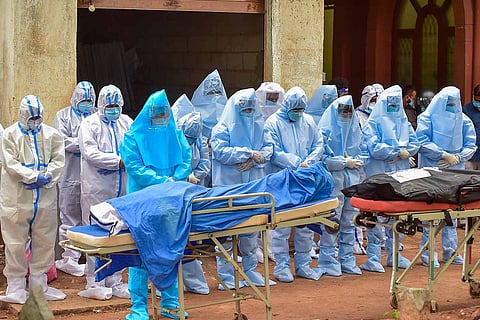

The death of Dr Simon Hercules, a neurosurgeon in Chennai, made headlines in April this year. A man who had spent his lifetime treating patients was denied dignity in death, after residents near a cemetery in Chennai assaulted his family, friends and health officials when his body was being buried. Similar incidents have been reported from other parts of the country, most recently in Andhra Pradesh’s Chittoor district. Residents of Ragampeta village laid a thorny fence to protest the proposal to set up a burial ground for COVID-19 victims. Those protesting feared that burying the body of a person who died of COVID-19 could spread the viral infection.
Cremations of persons who have succumbed to the novel coronavirus have also met with resistance and stiff opposition. In Hyderabad, the reopening of an electric crematorium for the cremation of COVID-19 victims sparked a protest among residents in the colony. Residents feared that smoke from the crematorium could pose a threat to their health.
In all of these cases, fear, ignorance and stigma attached to COVID-19 are the main triggers for such protests — that have sometimes taken a violent turn. So, is there any truth to these fears? And how does one ensure a safe burial/cremation for a COVID-19 victim that will not deny them a dignified funeral?
Speaking to TNM, Dr Shahid Jameel, a virologist and the Chief Executive Officer of the Wellcome Trust-DBT India Alliance, explains that a dead body can be infectious as the body still has fluids, which can transmit the SARS-CoV-2 virus that causes COVID-19.
“A dead body still has body fluids, still has saliva, and the virus is really there. It’s not the body per se, but secretions that are a source of infections. And therefore, bodies of COVID-19 victims should either be buried or cremated with care,” he says.
Dr Shahid rubbishes fears over the coronavirus spreading due to smoke from crematoriums. He points out, “There are studies to show that the virus is destroyed in 70 degrees in one minute. When you are burning a body, that decimates the body immediately.”
The Union Ministry of Health and Family Welfare (MoHFW) and the World Health Organisation (WHO) have come up with protocols on the safe disposal of a body of a suspected or confirmed case of COVID-19.
In its March 24 guidance, the WHO states that except in cases of hemorrhagic fevers (such as Ebola, Marburg) and cholera, dead bodies are generally not infectious. “Only the lungs of patients with pandemic influenza, if handled improperly during an autopsy, can be infectious. Otherwise, cadavers do not transmit disease,” states the WHO, adding, “It is a common myth that persons who have died of a communicable disease should be cremated, but this is not true.”
Both the MoHFW and the WHO emphasise that health workers handling bodies of COVID-19 victims must wear Personal Protective Equipment (PPE). At the time of preparing the body for transfer from the hospital, MoHFW guidelines state that all lines, catheters and tubes need to be removed and any puncture holes or injuries to the body should be disinfected with 1% hypochlorite and dressed with impermeable material. Furthermore, to ensure that bodily fluids do not leak, oral and nasal orifices of the dead body need to be plugged.
The dead body must be placed in a leak-proof plastic body bag, states MoHFW, adding, “The exterior of the body bag can be decontaminated with 1% hypochlorite.The body bag can be wrapped with a mortuary sheet or sheet provided by the family members.”
Both the MoHFW and the WHO advise against embalming the body.
The MoHFW details specific safety precautions for the staff at crematoriums and burial grounds including wearing PPE, and hand hygiene. The guidelines also make clear that following cremation, the ashes do not pose any risk and can be collected to perform the last rites.
As far as burials go, civic bodies like the Greater Hyderabad Municipal Corporation (GHMC) have ordered that a grave be dug at a depth of 10 feet. Disinfectant needs to be sprayed on the ground before the coffin is lowered into the grave. Once the grave is covered with soil, another disinfectant needs to be sprayed on the surface. A distance of three feet between two graves also needs to be maintained, state guidelines.